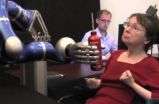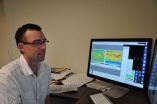(Press-News.org)
VIDEO:
This is a video showing and discussing results published in Nature from the BrainGate2 pilot clinical trial.
Click here for more information.
[Providence, R.I.] -- On April 12, 2011, nearly fifteen years after she became paralyzed and unable to speak, a woman controlled a robotic arm by thinking about moving her arm and hand to lift a bottle of coffee to her mouth and take a drink. That achievement is one of the advances in brain-computer interfaces restorative neurotechnology and assistive robot technology described in the May 17 edition of the journal Nature by the BrainGate2 collaboration of researchers at the Department of Veterans Affairs, Brown University, Massachusetts General Hospital, Harvard Medical School., and the German Aerospace Center (DLR).
A 58-year-old woman, "S3," and a 66-year-old man, "T2," participated in the study. They had each been paralyzed by a brainstem stroke years earlier which left them with no functional control of their limbs. In the research, the participants used neural activity to directly control two different robotic arms, one developed by the DLR Institute of Robotics and Mechatronics and the other by DEKA Research and Development Corp., to perform reaching and grasping tasks across a broad three-dimensional space. The BrainGate2 (www.braingate2.org) pilot clinical trial employs the investigational BrainGate system initially developed at Brown University, in which a baby aspirin-sized device with a grid of 96 tiny electrodes is implanted in the motor cortex—a part of the brain that is involved in voluntary movement. The electrodes are close enough to individual neurons to record the neural activity associated with intended movement. An external computer translates the pattern of impulses across a population of neurons into commands to operate assistive devices, such as the DLR and DEKA robot arms used in the study now reported in Nature.
BrainGate participants have previously demonstrated neurally based two-dimensional point-and-click control of a cursor on a computer screen and rudimentary control of simple robotic devices.
The study represents the first demonstration and the first peer-reviewed report of people with tetraplegia using brain signals to control a robotic arm in three-dimensional space to complete a task usually performed by their arm. Specifically, S3 and T2 controlled the arms to reach for and grasp foam targets that were placed in front of them using flexible supports. In addition, S3 used the DLR robot to pick up a bottle of coffee, bring it to her mouth, issue a command to tip it, drink through a straw, and return the bottle to the table. Her BrainGate-enabled, robotic-arm control during the drinking task required a combination of two-dimensional movements across a table top plus a "grasp" command to either grasp and lift or tilt the robotic hand.
"Our goal in this research is to develop technology that will restore independence and mobility for people with paralysis or limb loss," said lead author Dr. Leigh Hochberg, a neuroengineer and critical care neurologist who holds appointments at the Department of Veterans Affairs, Brown University, Massachusetts General Hospital and Harvard. He is the Sponsor-Investigator for the BrainGate2 pilot clinical trial. "We have much more work to do, but the encouraging progress of this research is demonstrated not only in the reach-and-grasp data, but even more so in S3's smile when she served herself coffee of her own volition for the first time in almost 15 years."
Partial funding for this work comes from the VA, which is committed to improving the lives of injured Veterans. "VA is honored to have played a role in this exciting and promising area of research," said VA Secretary Eric Shinseki. "Today's announcement represents a great step forward toward improving the quality of life for Veterans and others who have either lost limbs or are paralyzed."
Hochberg adds that even after nearly 15 years, a part of the brain essentially "disconnected" from its original target by a brainstem stroke was still able to direct the complex, multidimensional movement of an external arm – in this case, a robotic limb. The researchers also noted that S3 was able to perform the tasks more than five years after the investigational BrainGate electrode array was implanted. This sets a new benchmark for how long implanted brain-computer interface electrodes have remained viable and provided useful command signals.
John Donoghue, the VA and Brown neuroscientist who pioneered BrainGate more than a decade ago and who is co-senior author of the study, said the paper shows how far the field of brain-computer interfaces has come since the first demonstrations of computer control with BrainGate.
"This paper reports an important advance by rigorously demonstrating in more than one participant that precise three-dimensional neural control of robot arms is not only possible, but also repeatable," said Donoghue, who directs the Brown Institute for Brain Science. "We've moved significantly closer to returning everyday functions, like serving yourself a sip of coffee, usually performed effortlessly by the arm and hand, for people who are unable to move their own limbs. We are also encouraged to see useful control more than five years after implant of the BrainGate array in one of our participants. This work is a critical step toward realizing the long-term goal of creating a neurotechnology that will restore movement, control and independence to people with paralysis or limb loss."
In the research, the robots acted as a substitute for each participant's paralyzed arm. The robotic arms responded to the participants' intent to move as they imagined reaching for each foam target. The robot hand grasped the target when the participants imagined a hand squeeze. Because the diameter of the targets was more than half the width of the robot hand openings, the task required the participants to exert precise control. (Movies of these actions are also available on the Nature website.)
In 158 trials over four days, S3 was able to touch the target within an allotted time in 48.8 percent of the cases using the DLR robotic arm and hand and 69.2 percent of the cases with the DEKA arm and hand, which has the wider grasp. In 45 trials using the DEKA arm, T2 touched the target 95.6 percent of the time. Of the successful touches, S3 grasped the target 43.6 percent of the time with the DLR arm and 66.7 percent of the time with the DEKA arm. T2's grasp succeeded 62.2 percent of the time.
T2 performed the session in this study on his fourth day of interacting with the arm; the prior three sessions were focused on system development. Using his eyes to indicate each letter, he later described his control of the arm: "I just imagined moving my own arm and the [DEKA] arm moved where I wanted it to go."
The study used two advanced robotic arms: the DLR Light-Weight Robot III with DLR five-fingered hand and the DEKA Arm System. The DLR LWR-III, which is designed to assist in recreating actions like the human arm and hand and to interact with human users, could be valuable as an assistive robotic device for people with various disabilities. Patrick van der Smagt, head of bionics and assistive robotics at DLR, director of biomimetic robotics and machine learning labs at DLR and the Technische Universität München, and a co-senior author on the paper said: "This is what we were hoping for with this arm. We wanted to create an arm that could be used intuitively by varying forms of control. The arm is already in use by numerous research labs around the world who use its unique interaction and safety capabilities. This is a compelling demonstration of the potential utility of the arm by a person with paralysis."
DEKA Research and Development developed the DEKA Arm System for amputees, through funding from the United States Defense Advanced Research Projects Agency (DARPA). Dean Kamen, founder of DEKA said, "One of our dreams for the Luke Arm [as the DEKA Arm System is known informally] since its inception has been to provide a limb that could be operated not only by external sensors, but also by more directly thought-driven control. We're pleased about these results and for the continued research being done by the group at the VA, Brown and MGH." The research is aimed at learning how the DEKA arm might be controlled directly from the brain, potentially allowing amputees to more naturally control this prosthetic limb.
Over the past two years, VA has been conducting an optimization study of the DEKA prosthetic arm at several sites, with the cooperation of Veterans and active duty service members who have lost an arm. Feedback from the study is helping DEKA engineers to refine the artificial arm's design and function. "Brain-computer interfaces, such as BrainGate, have the potential to provide an unprecedented level of functional control over prosthetic arms of the future," said Joel Kupersmith, MD, VA Chief Research and Development Officer. "This innovation is an example of federal collaboration at its finest."
Story Landis, director of the National Institute of Neurological Disorders and Stroke, which funded the work in part, noted: "This technology was made possible by decades of investment and research into how the brain controls movement. It's been thrilling to see the technology evolve from studies of basic neurophysiology and move into clinical trials, where it is showing significant promise for people with brain injuries and disorders."
INFORMATION:
Additional statements can be found at http://news.brown.edu/pressreleases/2012/05/brainquote.
The BrainGate2 study continues to enroll participants to take part in this research and recently added Stanford University as a member of the collaboration and a clinical trial site.
In addition to Hochberg, Donoghue, and van der Smagt, other authors on the paper are Daniel Bacher, Beata Jarosiewicz, Nicolas Masse, John Simeral, Joern Vogel, Sami Haddadin, Jie Liu, and Sydney Cash.
About the BrainGate collaboration
This advance is the result of the ongoing collaborative BrainGate research at Brown University, Massachusetts General Hospital, Providence VA Medical Center; researchers at Stanford University have recently joined the collaboration as well. The BrainGate research team is focused on developing and testing neuroscientifically inspired technologies to improve the communication, mobility, and independence of people with neurologic disorders, injury, or limb loss.
Funding for the study and its projects comes from the Rehabilitation Research and Development Service, Office of Research and Development, U.S. Department of Veterans Affairs, the National Institutes of Health (some grants were funded all or in part through the American Recovery and Reinvestment Act), the Eunice Kennedy Shriver National Institute of Child Health and Human Development/National Center for Medical Rehabilitation Research (HD53403, HD100018, HD063931), the National Institute on Deafness and Other Communication Disorders, the National Institute of Neurological Disorders and Stroke (NS025074), the National Institute of Biomedical Imaging and Bioengineering (EB007401), the Doris Duke Charitable Foundation, the MGH-Deane Institute for Integrated Research on Atrial Fibrillation and Stroke, Katie Samson Foundation, the Craig H. Neilsen Foundation and the
European Commission's Seventh Framework Programme through the project The Hand Embodied (grant 248587).
The contents do not represent the official views of the Department of Veterans Affairs or the United States Government.
The implanted microelectrode array and associated neural recording hardware used in the BrainGate research are manufactured by BlackRock Microsystems, LLC (Salt Lake City, Utah). The research prototype Gen2 DEKAarm was provided by DEKA Integrated Solutions, Inc, under contract from the Defense Advanced Research Project Agency (DARPA).
The BrainGate pilot clinical trial was previously directed by Cyberkinetics Neurotechnology Systems, Inc. Foxborough, Mass, (CKI). CKI ceased operations in 2009, before the collection of data reported in the Nature manuscript. The clinical trials of the BrainGate2 Neural Interface System are now administered by Massachusetts General Hospital, Boston, Mass. Donoghue is a former chief scientific officer and a former director of CKI; he held stocks and received compensation. Hochberg received research support from Massachusetts General and Spaulding Rehabilitation Hospitals, which in turn received clinical trial support from Cyberkinetics.
CAUTION: Investigational Device. Limited by Federal Law to Investigational Use. The device is being studied under an IDE for the detection and transmission of neural signals from the cortex to externally powered communication systems, environmental control systems, and assistive devices by persons unable to use their hands due to physical impairment. The clinical trial is ongoing; results presented are thus preliminary. The safety and effectiveness of the device have not been established.
People with paralysis control robotic arms to reach and grasp using brain computer interface
2012-05-17
ELSE PRESS RELEASES FROM THIS DATE:
New Fotobabble App Transforms Websites Into Social Marketing Channels, Everloop.com Selects Fotobabble for Websites to Power Greyson Chance INSPIRE Contest
2012-05-17
Fotobabble, a leader in social media marketing solutions, announced the release of Fotobabble for Websites today, a new application that for the first time lets an organization run photo and audio-driven campaigns and promotions directly from any website. With Fotobabble for Websites brands and businesses can increase web traffic and audience engagement through the visual impact of photos, the emotion of voice and the power of social media.
Everloop.com, the leading online social site for kids and tweens, selected Fotobabble for Websites to power its INSPIRE contest ...
Paralyzed individuals use thought-controlled robotic arm to reach and grasp
2012-05-17
In an ongoing clinical trial, a paralyzed woman was able to reach for and sip from a drink on her own – for the first time in nearly 15 years – by using her thoughts to direct a robotic arm. The trial, funded in part by the National Institutes of Health, is evaluating the safety and feasibility of an investigational device called the BrainGate neural interface system. This is a type of brain-computer interface (BCI) intended to put robotics and other assistive technology under the brain's control.
A report published today in Nature describes how two individuals – both ...
A deeper look at Centaurus A
2012-05-17
Centaurus A, also known as NGC 5128 [1], is a peculiar massive elliptical galaxy with a supermassive black hole at its heart. It lies about 12 million light-years away in the southern constellation of Centaurus (The Centaur) and has the distinction of being the most prominent radio galaxy in the sky. Astronomers think that the bright nucleus, strong radio emission and jet features of Centaurus A are produced by a central black hole with a mass of about 100 million times that of the Sun. Matter from the dense central parts of the galaxy releases vast amounts of energy as ...
Manmade pollutants may be driving Earth's tropical belt expansion
2012-05-17
RIVERSIDE, Calif. — Black carbon aerosols and tropospheric ozone, both manmade pollutants emitted predominantly in the Northern Hemisphere's low- to mid-latitudes, are most likely pushing the boundary of the tropics further poleward in that hemisphere, new research by a team of scientists shows.
While stratospheric ozone depletion has already been shown to be the primary driver of the expansion of the tropics in the Southern Hemisphere, the researchers are the first to report that black carbon and tropospheric ozone are the most likely primary drivers of the tropical ...
Understanding breast cancer
2012-05-17
In a study published today in Nature, researchers describe nine new genes that drive the development of breast cancer. This takes the tally of all genes associated with breast cancer development to 40.
The team examined all the genes in the genomes of 100 cases of breast cancer. The mutated cancer-causing genes were different in different cancer samples, indicating that breast cancer is genetically very diverse. Understanding the consequences of this diversity will be important in progressing towards more rational treatment.
Changes to DNA lie behind all cases of cancer. ...
Predicting cancer relapse: Study finds high-throughput sequencing bests flow cytometry
2012-05-17
SEATTLE – A study led by researchers at Fred Hutchinson Cancer Research Center has found that a next-generation, high-speed DNA-decoding technology called high-throughput sequencing can detect the earliest signs of potential relapse in nearly twice the number of leukemia patients as compared to flow cytometry, the current gold standard for detecting minimal residual disease. The results of the study, led by Hutchinson Center computational biologist Harlan Robins, Ph.D., are reported in the May 16 issue of Science Translational Medicine.
"The ability to predict disease ...
Dentist in Kentwood, MI Announces the Recent Launch of Hahn Dental Group's Mobile Website
2012-05-17
While the mobile community continues to grow, Dr. Hahn, dentist in Kentwood, MI, is happy to offer an advanced mobile website to better meet the needs of patients who are constantly on the go. Today, in a technologically advanced society, more and more people are utilizing their smart phones and tablet devices for their daily needs. From ordering food to looking up important information, patients use their smart phones and tablet devices on a daily basis.
By offering a mobile website, Dr. Hahn, dentist in Kentwood, enhances his patients' ability to receive important ...
NIH-funded research provides new clues on how ApoE4 affects Alzheimer's risk
2012-05-17
Common variants of the ApoE gene are strongly associated with the risk of developing late-onset Alzheimer's disease, but the gene's role in the disease has been unclear. Now, researchers funded by the National Institutes of Health have found that in mice, having the most risky variant of ApoE damages the blood vessels that feed the brain.
The researchers found that the high-risk variant, ApoE4, triggers an inflammatory reaction that weakens the blood-brain barrier, a network of cells and other components that lines brain's brain vessels. Normally, this barrier allows ...
Saginaw Township Dentist Improves Practice Through Patient Reviews
2012-05-17
Dr. Greg Herzler, Saginaw Township dentist, appreciates his patients' feedback about his practice. By leaving reviews, patients help Dr. Herzler to improve his practice to better serve his patients. Patients can visit the practice's website for instant access to available links to leave their feedback on the review site of their choice.
"I always look forward to hearing from my patients about their experience with my office. By leaving reviews, my patients allow me to constantly improve my practice and the way we serve our patients. I hope to continue to provide ...
Movement patterns of endangered turtle vary from Pacific to Atlantic
2012-05-17
The movement patterns of critically endangered leatherback turtles vary greatly depending on whether the animals live in the North Atlantic or the Eastern Pacific, with implications for feeding behavior and population recovery, according to research published May 16 in the open access journal PLoS ONE.
The authors, led by Helen Bailey of the University of Maryland Center for Environmental Science, found that turtles in the Atlantic had two travel modes, low and high speed, associated with foraging and transit, respectively. The Pacific turtles, on the other hand, only ...





